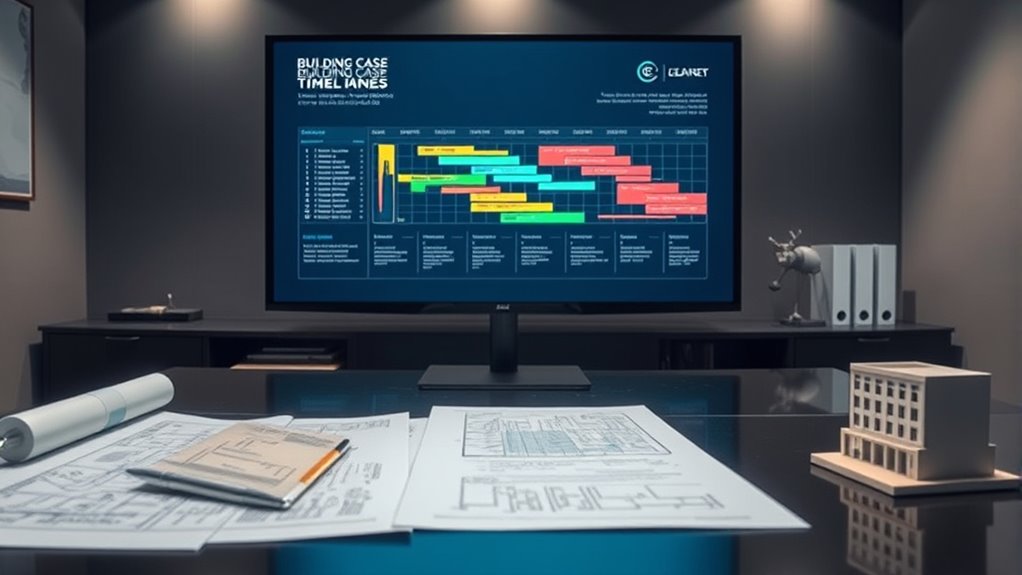To build a case timeline, start by gathering all relevant evidence and organizing it systematically for quick access. Use digital tools like timeline software to map events in chronological order, ensuring each entry is precise with solid evidence and detailed descriptions. Regularly update the timeline as new information emerges to keep it accurate. Incorporate visual elements and creative touches to enhance clarity and presentation—continue exploring to learn how these steps come together seamlessly.
Key Takeaways
- Organize all relevant evidence systematically for quick access and to identify gaps.
- Use visual tools like charts or digital software to map events chronologically.
- Back each timeline entry with precise dates and detailed, consistent descriptions.
- Utilize digital timeline software to drag, annotate, and dynamically adjust case events.
- Regularly update the timeline to reflect case developments and support strategic decision-making.

Creating a clear and detailed case timeline is essential for managing legal cases effectively. When you’re working through complex information, having a well-structured timeline helps you see the big picture and track each development accurately. To build an effective case timeline, you start by gathering all relevant evidence and organizing it systematically. Evidence organization is critical because it allows you to quickly access key documents, witness statements, and other materials that support your case. When everything is properly sorted, you reduce the risk of overlooking critical details, and it becomes easier to identify gaps or inconsistencies in your evidence.
A well-organized evidence collection helps you track key details and identify gaps effectively.
Once you’ve organized your evidence, the next step is to develop timeline visualization. Visual tools like charts, graphs, or digital timeline software make it simpler to map out events chronologically. Timeline visualization transforms a jumble of data into a clear, visual sequence of events, which helps you better understand how different pieces of evidence relate to each other. This visual approach allows you to recognize patterns, pinpoint critical moments, and anticipate possible challenges or questions from the opposition. It’s also invaluable when communicating your case to colleagues, clients, or judges, as a visual timeline can make complex sequences more accessible and easier to follow.
As you build your case timeline, focus on precision and clarity. Make sure each entry is backed by solid evidence and clearly dated. Avoid vague descriptions; instead, specify exact dates and precise details to maintain accuracy. Using a consistent format for entries ensures your timeline remains easy to read and interpret. It’s also helpful to regularly update your timeline as new evidence surfaces or as your case develops. This ongoing process keeps your case well-organized and ensures your timeline remains an accurate reflection of the current situation. Moreover, understanding the importance of antique elements in creating a warm and inviting atmosphere can inspire creative ways to present your evidence or case narrative visually.
Additionally, leveraging digital tools for timeline visualization can considerably streamline your workflow. Many software options allow you to drag and drop evidence, add annotations, and adjust timelines dynamically. These tools often include features that enable you to filter or highlight specific events, making it easier to focus on critical aspects during strategy sessions or court presentations. By combining evidence organization with effective timeline visualization, you create a thorough overview that facilitates strategic decision-making and case management.
Frequently Asked Questions
What Tools Are Best for Building Case Timelines?
For building case timelines, you should focus on software selection that offers strong data visualization features. Tools like Timeline Maker, Microsoft Project, or Trello can help you visualize complex data clearly and efficiently. These programs allow you to organize events chronologically, spot patterns, and present your case effectively. Choose software that suits your needs, is user-friendly, and integrates well with your existing data sources for the best results.
How Long Does It Typically Take to Create a Comprehensive Timeline?
You might be surprised, but creating a thorough case timeline usually takes between a few hours to several days, depending on complexity. With effective timeline visualization, you can quickly organize events into a clear case chronology. The key is gathering all relevant data early and using the right tools. This process becomes faster as you streamline your workflow, ensuring your timeline accurately reflects every essential detail without unnecessary delays.
Can Timelines Be Customized for Different Case Types?
Yes, timelines can definitely be tailored for different case types. You’ll find plenty of timeline flexibility, allowing you to adjust details, events, and pacing based on your case’s unique needs. We focus on case-specific customization, so your timeline aligns perfectly with your case’s complexity and key milestones. This ensures your timeline remains clear, relevant, and tailored, helping you manage your case efficiently and effectively.
How Do We Ensure Accuracy in Timeline Details?
To guarantee accuracy in timeline details, you verify each entry through accuracy verification and source validation. You double-check dates, facts, and events against reliable sources, cross-referencing multiple records when possible. This process helps catch mistakes early and maintains the timeline’s integrity. By staying vigilant and methodical, you can confidently produce precise, trustworthy timelines that support your case effectively.
What Common Mistakes Should Be Avoided When Building Timelines?
Imagine your timeline is a delicate tapestry; one wrong thread can distort the whole picture. To avoid timeline pitfalls, double-check dates and details, and don’t rely on memory alone. Watch out for accuracy pitfalls like assumptions or overlooked sources. Stay vigilant, cross-reference facts, and keep your information organized. By doing so, you guarantee your timeline remains a true, unblemished story, free from errors that could unravel your case.
Conclusion
So, there you have it—building case timelines is truly a breeze, isn’t it? Just gather your facts, slap them onto a timeline, and watch the magic happen. Who knew legal work could be so straightforward? Now, armed with this shiny new skill, go forth and conquer those cases with the confidence of a seasoned pro—because if you can build a timeline, you can conquer the legal universe. Easy peasy!









